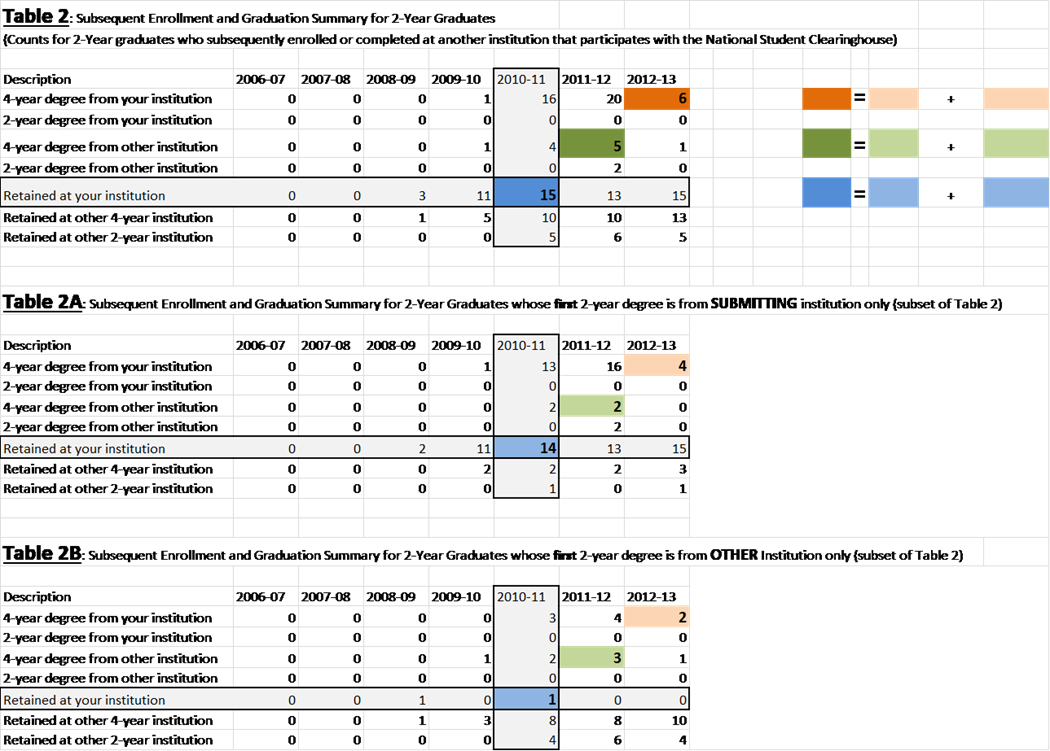Table of Contents
For CO queries, the system generates a cohort report in place of the aggregate report. The data in the cohort report tables is used to populate the Student Achievement Measure (SAM).
Example Cohort Report
Click to enlarge.
Cohort Report Filename Format
[FTP Username]_T#####cohortrpt.YYYYMMDDHHMM_CO.csv
Cohort Report Tables
Tables 1 & 2
- Table 1: Provides graduation and retention counts for consecutive academic years based on your search date.
- Table 2: Provides subsequent graduation and retention counts for students who have already completed a two-year degree.
Tables 2A & 2B
Tables 2A and 2B are subsets of Table 2.
- Table 2A: Provides information on students who subsequently enrolled after earning their first two-year degree from the submitting institution.
- Table 2B: Provides information on students who subsequently enrolled after earning their first two-year degree from another institution.
The sum of corresponding values in 2A and 2B yields the total in Table 2. In the following example, the sum of the Retained at your institution numbers in light blue in 2A and 2B for 2010-11 yields the dark blue total in Table 2. Same for the green and orange values.
Academic Years
A student’s enrollment and degree history is separated into academic years based on the search date provided in your request file in column H. For example, if the CO query search date is 20010915, the first academic year reported will be 9/16/2001 – 9/15/2002 and shown as 2001-2002 in the report. The second academic year will be 9/16/2002 – 9/15/2003 and shown as 2002-2003. This will continue for subsequent years, up to the current academic year.
![]() For CO queries, the search date must be the same for all students in the file.
For CO queries, the search date must be the same for all students in the file.
Given a search data of 20010915, for example, the academic year is reported as 2001-2002 and the records relevant for this year are:
- Enrollment records for terms at two-year or four-year institutions that ended between 9/16/2001 and 9/15/2002 (regardless of their begin dates) where students were enrolled at a full-time, three-quarter-time, half-time or less-than-half-time status. Specific enrollment records at less-than-two-year institutions or those where the student’s status was reported as W (withdrawn), D (deceased), or A (leave of absence) are not included in the cohort report.
- Degree records with award dates between 9/16/2001 and 9/15/2002. The query counts all bachelor’s, master’s, professional and doctoral degrees as valid four-year degrees and uses the degree title information when available. If degree title information is not available, they system uses the institutional type (two- or four-year). Associate degrees are counted as two-year degrees. Certificates, honors, and awards are not counted.
While a student could have multiple records for 2001-2002, each student is only counted in one outcome for each academic year using the following hierarchy.
Completion
| Outcome | Priority |
| Four-year degree from your institution | 1 |
| Four-year degree from other institution | 2 |
| Two-year degree from your institution | 3 |
| Two-year degree from other institution | 4 |
Retention/Persistence
| Outcome | Priority |
| Retained at your institution | 5 |
| Retained at other four-year institution | 6 |
| Retained at other two-year institution | 7 |
For example, if a student had the following records for 2001-2002, the report will reflect a priority of 3.
- Enrollment from the submitting institution (priority = 5)
- A two-year degree from the submitting institution (priority = 3)
- Enrollment from another four-year institution (priority = 6)
Terminal Events
- Two-year degrees are not terminal events in the enrollment and graduation summary tables. When a student completes a two-year degree, any subsequent enrollment or degree completions will be counted in subsequent years. Table 1 records their initial two-year degree and Table 2 records their subsequent activity.
- Four-year degrees are terminal events in the enrollment and graduation summary tables. Once a student has completed a four-year degree, all subsequent enrollment and degree records are not counted. For example, if a student completes a four-year degree from another institution and later returns to your campus and completes a four-year degree, the second four-year degree is not counted.
Institutions who include both two-year and four-year graduates in their graduation rates must have the initial two-year degree counts backed out of Table 1. For institutions that participate with VSA’s College Portrait, VSA’s code handles this after the cohort report data is uploaded to the College Portrait site. For institutions that do not participate with College Portrait but would like similar success and progress calculations, there is an Excel spreadsheet that produces some basic measures.



